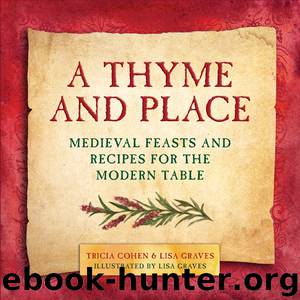A Thyme and Place by Lisa Graves

Author:Lisa Graves
Language: eng
Format: epub
Publisher: Skyhorse Publishing
Published: 2016-03-31T04:00:00+00:00
St. John’s Eve/Midsummer’s Eve
Celebrated between June 21st and June 25th
Get the bonfire going and dance, but don’t forget your wort.
The History
Midsummer’s Eve (or St. John’s Eve for the Christians) is an ancient festival celebrating the summer solstice. Bonfires were lit to ward off bad spirits and drive out dragons!
In the fourteenth century, celebrations took a sinister turn—it was thought this was a powerful night for witches to congregate. It was also believed by the church that the merrymaking was completely out of hand (a bit of a trend in these times), so they ordered their parishioners to see it as a day of fasting and not gluttony.
The name “St. John’s Eve” refers to St. John the Baptist’s birth. According to the Gospel of Luke, John was born six months before Jesus, and it is one of the very few saint feast days that commemorates a birth as opposed to a death.
Evil Plants? Really?
In many parts of the world, women would collect plants on this night—fennel, rosemary, foxgloves, elderflowers, and, as you probably guessed, St. John’s wort. Since before medieval times, this plant was believed to ward off evil. Branches were hung over doorways and windows for protection not only from evil but also from witches. Cackle.
Which brings us to St. John’s Day in New Orleans. Many NOLA residents still celebrate this night with voodoo rituals, all of which began with the famous voodoo priestess, Marie Laveau. She held all of her most important rituals on this night in the 1800s. We could do a whole book on New Orleans food, but while we’re on the subject, if you’re ever down there check out the Erin Rose on 811 Conti Street, order a beer, head straight to the back, and order a po’ boy.
Goody Goody
Back to medieval food—this holiday was marked by a dish called “goody” (mostly in Ireland). It was nothing more than basic white bread soaked in hot milk and flavored with sugar and spices. Hmm . . . sounds like bread pudding, right? Villagers would make this “goody” in large pots at the communal St. John’s Eve bonfire. Anyone celebrating or attending the bonfire would bring their own spoon and small bowl to share the pudding. While this pudding party might suggest a similarly inspired recipe in the next few pages, we’ve reserved pudding for a few other feasts and planned a more sophisticated homage to St. John’s Eve with a sweet summer wine and a shrimp and lobster dish you can share with friends around the bonfire.
Download
This site does not store any files on its server. We only index and link to content provided by other sites. Please contact the content providers to delete copyright contents if any and email us, we'll remove relevant links or contents immediately.
A Court of Wings and Ruin by Sarah J. Maas(7651)
The Death of the Heart by Elizabeth Bowen(3551)
The Sprouting Book by Ann Wigmore(3543)
Better Homes and Gardens New Cookbook by Better Homes & Gardens(3525)
BraveTart by Stella Parks(3395)
Salt, Fat, Acid, Heat: Mastering the Elements of Good Cooking by Nosrat Samin(3108)
Sauces by James Peterson(3051)
Kitchen confidential by Anthony Bourdain(3009)
The Bread Bible by Rose Levy Beranbaum(3004)
Classic by Mary Berry(2942)
Solo Food by Janneke Vreugdenhil(2929)
Ottolenghi - The Cookbook by Yotam Ottolenghi(2871)
Martha Stewart's Baking Handbook by Martha Stewart(2796)
Day by Elie Wiesel(2720)
Betty Crocker's Good and Easy Cook Book by Betty Crocker(2679)
The Plant Paradox by Dr. Steven R. Gundry M.D(2547)
My Pantry by Alice Waters(2545)
The Kitchen Counter Cooking School by Kathleen Flinn(2486)
Hot Sauce Nation by Denver Nicks(2451)
